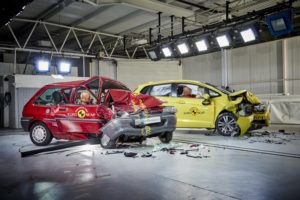Euro NCAP’s life-saving work in focus

Two decades of advances in crash safety, driven by the Euro NCAP programme.
Saving lives
Prior to Euro NCAP, car makers had to meet only basic legislative crash test requirements for new cars. They conducted their own crash tests but they were not standardised – and the results were not published. Euro NCAP’s programme introduced like-for-like tests have been conducted by independent experts; it’s revealed potential safety dangers in top-selling family cars, and lead to major carmakers rethinking their design.
It’s pushed huge improvements; safety technologies that were either not used at all or were optional – such as driver and passenger airbags, side curtain airbags, seatbelt reminders and electronic stability control – are now standard on most cars sold in Europe. According to Thatcham Research, which conducts UK tests for Euro NCAP, you’re now twice as likely to walk away from a car crash than you would have been 20 years ago.
Technology that works
Back in 1997, Euro NCAP performed its first ever crash test on the Rover 100; at the time one of Britain’s most popular cars. Subjected to a 40mph frontal offset crash in the Thatcham Research Crash Lab, it received only one star and was withdrawn from sale shortly afterwards.
Almost two decades later, the comparatively-priced current-generation Honda Jazz illustrates just how far safety has come on since. The Jazz holds a five-star rating and is recognised by Thatcham Research as a strong performer.
Changing buying decisions
Euro NCAP hasn’t just focused on running its tests though and both consumers and fleets are regularly urged to only buy Five Star-rated cars with collision avoidance technology like Autonomous Emergency Braking (AEB) and Lane Assist systems. It has also called on manufacturers to make AEB standard fitment, to prevent thousands of accidents.
Thatcham Research, which conducts Euro NCAP tests in the UK, has estimated that if AEB became standard on every new car sold in the UK, it would save 2,700 pedestrian and cyclist deaths and serious injuries every year. Or 54,000 fewer over 20 years.
Setting new standards
Since 1997, Euro NCAP tests have become ever more demanding. Not only now can cars achieve a five-star maximum rating compared to the original four stars, but tests also offer child and pedestrian protection ratings, incorporate whiplash and ESC testing and also reward advanced technologies, to name but a few updates.
Euro NCAP is introducing new tests in 2018, covering: Lane Assist systems to control steering if there are potential risks; tests to reduce crashes at junctions; Pedestrian AEB that works at night time and new AEB cyclist detection tests to encourage manufacturers to further enhance these important technologies.
Euro NCAP’s work in numbers:
9 out of 10 – cars sold on the European market holding a Euro NCAP rating
182,000 – deaths and serious injuries in road crashes that have been prevented on UK roads since Euro NCAP’s testing was introduced
2,700 – deaths and serious injuries in the UK could be saved every year if AEB that can sense both pedestrians and cyclists became standard on every new car

















